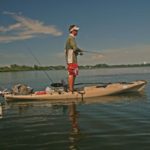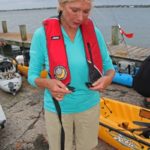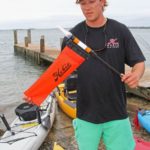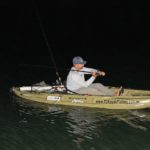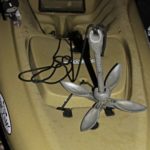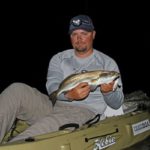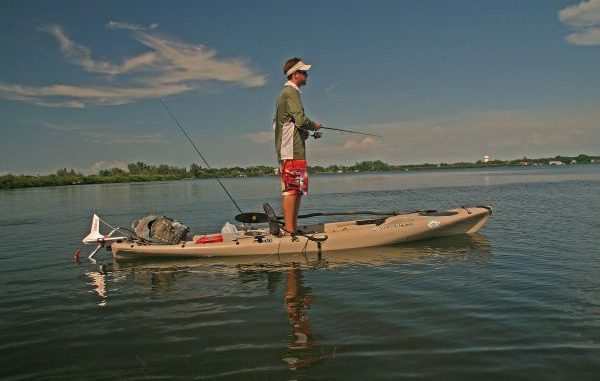
Kayaks offer an affordable way to get out on the water, but there are some considerations. Here are some tips on how to rig up your first ’yak.
Warming weather, active fish — we’re all feeling the urge to indulge in a little after hours angling action. Options are many, but for stealth and access, it’s hard to beat a kayak.
For inshore and coastal purposes, a sit-on model is the way to go. Sit-in styles are not wrong and you can certainly have a fine time with such models; but kayak guide Capt. Brian Nelli said that in southern climates where temperatures rarely fall to levels that merit the insulation of a sit-in kayak, anglers will appreciate the versatility of a sit-on.
For one thing, it’s much easier to get in and out of a sit-on. Want to cool your legs? Just dangle them overboard. Legs can also serve as rudders if you opt to forgo the real thing.
And if you find a spot that beckons a wading approach, yours will be an easy transition.
Fishing kayaks usually fall in the 10- to 12-foot range. When choosing kayak length, consider personal paddling/steering ability, but know that longer boats offer better tracking because of greater surface contact. Windy days might blow a shorter yak around more, but the trade-offs are lighter weight for storage and traveling, lower cost and greater ability to slip into tight spots.
If you want the option of fishing with another person, go with a tandem kayak. It’s cheaper than buying two ’yaks, but consider the additional size, weight and maneuverability limitations.
Stay safe
The list of kayak gear and accessories will vary by individual (See ADD-ONS), but personal flotation devices are on the top of that list. Modern PFDs are slim enough to wear comfortably while paddling and fishing, but if you’d rather keep yours on standby, keep it within easy reach under the shock cords on your storage area fore or aft.
Morgan Promnitz, Hobie’s fishing product manager, knows visibility remains a constant concern for kayakers sharing waterways with motorboats. To ensure he is seen by motorboat operators, he’ll rig his yak with a lighted flag.
“At night, you want to make sure that (motorboaters) know you’re there,” Promnitz said. “Kayaks sit low to the water, so it’s easy for a boater to miss a kayak. A signal flag is an important safety device, and one with a lighted tip will help keep you visible on the water.”
Nelli said other key safety measures include installing reflective tape on the sides of a kayak, tying glow sticks to the bow and the stern, and using a whistle to alert boaters and/or to call for help in the event of an emergency.
On the go
Nelli fishes a 12-foot Hobie Outback with the Mirage Drive paddle system. Driven by foot pedals, this drive system uses paddles that cross laterally below the kayak, while a hand-operated rudder control keeps him on course.
“I used to paddle for a long time, and never thought I needed this, but after using one I see how easy it is to travel in a kayak,” Nelli said. “You use your legs on a daily basis anyway, so your legs are usually stronger than your arms.”
And pedaling instead of paddling comes in handy if your goal is catching fish.
“Keeping your hands free is important when fishing heavy vegetation,” Nelli said.
No doubt, operating a pedal-driven kayak is much easier than learning the proper paddling technique. However, Nelli advises anglers to also learn to effectively paddle a kayak.
“You don’t want to get stranded if you damage your Mirage Drive and have no way to get back,” he said.
Beginners will want to stay seated, but after gaining experience with kayak balancing, standing in the cockpit affords greater field of vision while enabling you to use your paddle for stroking propulsion similar to that of a standup paddleboard, but also as a push pole in shallow spots — or steering off of trees, docks, etc.
Stock reminds anglers that most kayak paddles separate in the middle — a handy benefit for negotiating tight spaces. Not only does this shorten your paddle, but it allows you to propel vessel canoe style, rather than the traditional kayak stroke.
Creative use of lumber can yield an impromptu trolling motor mount, but Stock has also rigged one of his ’yaks with a task-specific motor called a Torqeedo Ultralight 403 (www.torqeedo.com) that provides an extra push when fighting strong wind or current, while also providing an alternative to peddle or pedal power.
“This extends my range so I can cover more water in a day,” Stock said. “It doesn’t add a lot of extra weight to my kayak and it doesn’t increase the draft, so I can still go as shallow as I need to.”
Time to stop
However you propel your kayak, there will be times you’ll want to stop and hold your position to fish a dock, oyster bar, grass line, etc. Nelli likes a collapsible claw anchor, which sits right in the cockpit until needed.
“I’d recommend investing in an anchor trolley, which mounts to the side of your kayak and allows you to move the anchor from front to back for all conditions,” Nelli said.
Another option is one of the various commercially made stake-out poles such as the Wang (www.wanganchor.com), a ¾-inch wooden dowel or a mop handle.
There are two options when using stakeout anchors.
First, affix a rope leach and a fastening clip to the handle end, stick your stake-out pole into the water bottom and let out sufficient rope for your desired position.
The second option addresses those quick-stop needs with a shorter rod — maybe 2 feet — stuck through one of your cockpit scupper holes. You’ll need at least a semi-firm bottom; don’t waste your time in thick mud, as the short rod will slip and allow your boat to move out of position.
Also, be aware that sticking this anchoring device approximately amidships creates a pivot point that can turn your kayak into a merry-go-round. Prevent spinning in windy conditions by bracing one end of your paddle against the bottom or just handing a foot over the side.
Angling action
With trout, redfish and flounder, the kayak angler’s most common night-fishing species, you can streamline your bait selection to minnows, finger mullet and shrimp.
Similarly, artificials can be pared down to those that mimic a small baitfish or that all-purpose crustacean.
A selection of lure sizes and colors will help you take advantage of nightly preferences, but don’t overdo it with the backup rods: You’ll usually want to have a topwater and a subsurface bait ready for action, but make sure you don’t create a tangle fest with too many rods.
“I like two rods — I can usually do whatever I need to do with just two,” Nelli said. “If you’re fishing a tournament, use as many as you want, but usually more than two rods is just clutter for me.”
Most fishing kayaks come with a pair of flush-mounted rod holders positioned behind the seat — good spots for backup rods or a net, but also nice for trolling/drifting.
Experienced anglers also install a pivoting rod holder in the cockpit to keep the active rod secure while rigging or handling a fish.
“Be aware of what’s behind you,” Nelli said. “A lot of people aren’t used to having rods behind them, so pay attention to your casting angles. The same goes for trees, docks or any other structure behind you.”
If you’re having trouble with entanglements, a low, sidearm cast will help. Also, Nelli said that adjusting your seat so you maintain an upright posture — in other words, you’re not leaning back — will further improve your casting control.
